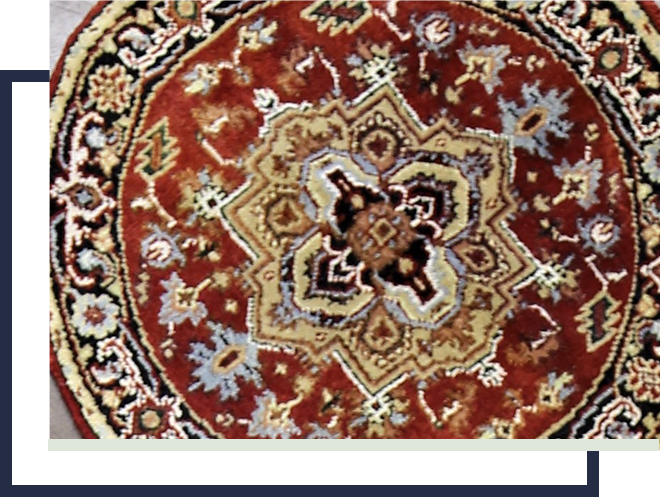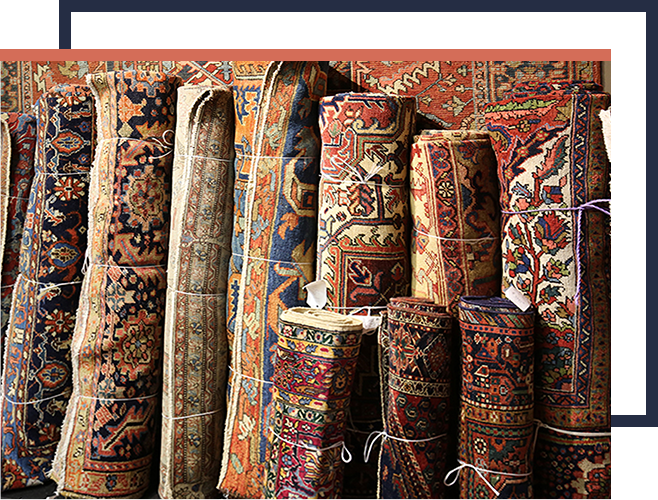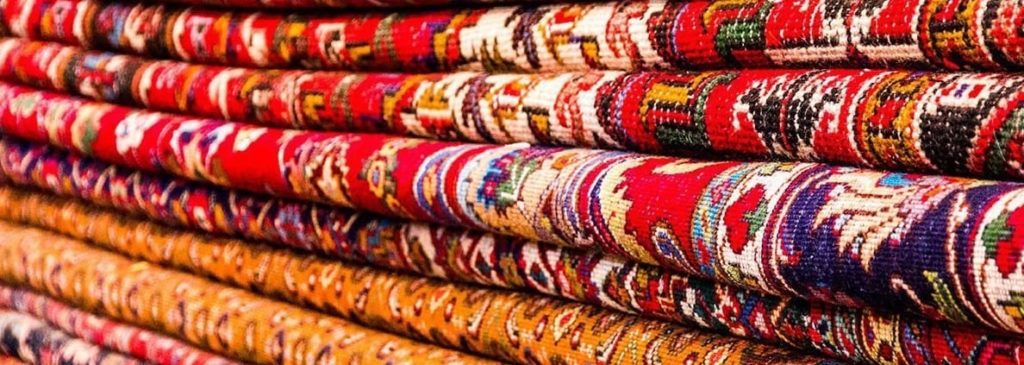Menu
Types of Rugs
One-of-a-Kind Hand Knotted Rugs
All rugs are not created equal. A knotted rug has pile that’s tied around the foundation, and the yarn can’t be pulled out—meaning it can last forever. It may take up to a year for a weaver to produce a hand-knotted rug, but they’re the most desirable because they’re truly one of a kind.

After someone stole all the carpet and floor coverings from my house, police believe it was the work of rug addicts.

Rug Styles and Origins
All rugs are not created equal. A knotted rug has pile that’s tied around the foundation, and the yarn can’t be pulled out—meaning it can last forever. It may take up to a year for a weaver to produce a hand-knotted rug, but they’re the most desirable because they’re truly one of a kind.
Menu

India
Carpets and rugs have been produced in India since as early as 500 BC, although Indian carpet weaving did not flourish until after the establishment of the Mughal Dynasty in the 15th century. The Mughal emperor Akbar brought Persian craftsmen to India and their style fused with existing Indian techniques to form the foundation for Indian carpet and rug weaving.
The presence of vines, floral patterns, animals, birds, and geometric and calligraphic patterns are common in traditional Indian rugs and carpets. The coloring found in Indian rugs has been greatly influenced by the art’s roots in Persian weaving and, therefore, multiple shades of blue and green, among other colors, set against a red background are very popular.
Kashmir is the northwestern region of the Indian subcontinent, famous for the production and export of Cashmere wool. Although shawl making, most notably Pashmina shawls, is the primary type of weaving associated with Kashmir, rugs and carpets are also widely produced in this area. Kashmir, along with Jaipur, Agra, and Bhadohi, is one of the primary centers for the Indian carpet and rug industry.

Iran (Persian)
Iran is home to the world-famous Persian carpet. Carpet-weaving is one of the most distinctive and notable expressions of Persian culture and art, which dates back to at least 500 BC. Today, hand-woven carpets produced by an estimated population of 1.2 million weavers are exported from Iran to account for 30% of the world’s hand-woven carpets to more than 100 countries, totaling about $420 million in revenue.
Persian carpets are traditionally known for their tremendous variety in design, color, size, and weave. Moreover, they are known for the uniqueness of each and every rug produced. Rugs are generally named after the village, town or district where they are woven or collected, or by the weaving tribe in the case of nomadic pieces. Each rug’s particular pattern, palette, and weave are uniquely linked with the indigenous culture, and weaving techniques are specific to an identifiable geographic area or nomadic tribe.
Located in northwest Iran, Bijar is known for producing rugs that are exceptionally stiff, heavy, thick, and durable. The rugs are beaten during the weaving process to make the rugs denser, which accounts for the durability. This weave serves as the primary means of identification of a Bijar rug, as the patterns and colors used vary greatly.
Heriz, a village in northwest Iran, is known for its carpets featuring bold, geometric patterns and designs containing a dominant center medallion. Luxuriant reds, blues, greens, and yellows set against ivory are typical of Heriz rugs. Highly stylized floral motifs, stepped center medallions, and double outlining, a design technique where the main aspect of the rug is separated from the field by two lines in different colors, set these rugs apart from other Persian rugs.
One of the largest, most important centers for Persian rug-weaving, Isfahan is located in central Iran and was once the capital of Persia. Classic Isfahan rugs date back to the Safavid Dynasty, which lasted from 1501 to 1736, but the city is still the site of major production, with these carpets being some of the most highly sought after around the world. Rugs produced in Isfahan usually display ivory backgrounds against blue, rose, magenta, saffron, and indigo motifs that form symmetrical, balanced designs. Center medallions are very common, as are arabesque tendrils, vines, palmettos, and cloud bands.
Now known as Arak, Sultanabad produces Western-influenced carpets that differ greatly from most other Persian rugs. The rug industry located here played an important role in commercializing the production of Persian rugs and carpets. With a reputation for high-quality construction, Swiss import company Ziegler & Co. established workshops in this area in the late 1800s to maximize the scale of output and profit margins. Rich, warm colors and large-scale design elements are usually found in these rugs, which also tend to be quite large.
Kashan, situated in north central Iran, yields some of the very finest Persian rugs and carpets available. A center of silk production since the 16th century, many of the best Persian silk rugs have been attributed to Kashan, although high-quality wool carpets are produced there as well, at least since the end of the 19th century. These rugs often contain elongated center medallions and corner spandrels, with little to no blank space. All-over patterns are not uncommon either, with repeated floral, vase, vine, scroll, and leaf designs contained within a central border within two smaller contrasting bands.
The city of Tabriz in northwest Iran is considered one of the most important rug-weaving centers in Iran and is home to some of the most skilled and artistic weavers in the world. Always handmade, the patterns, colors and the large number of hues used are characteristics of a Tabriz rug. The palette used may range from dark red and navy blue to ivy, tan, soft green and other pastels. These rugs are known for the large number of colors used in a single piece. They usually have intricate patterns, with small and complicated details. Most Tabriz rugs have a medallion in the middle and quarters of medallion at the corners, but there are some which may have geometric, simpler patterns where floral motifs are predominant, with vases, palmettos and hunting scenes near the edge.
Rugs from Malayer, a town in northwest Iran, are typically very thick and vary widely in pattern, including both medallion and allover designs, although patterns do tend to be somewhat abstract or geometric. Boteh, a paisley design and herati, a flower centered in a diamond with curving leaves surrounding the diamond, are both common, as is the use of empty space. Blue, red, cream, and orange are frequently seen in these rugs.
The city of Mashhad is one of the oldest centers of carpet weaving in the world and is still home to extensive carpet manufacturing. Curved lines, central medallions, corner floral designs, and densely decorated backgrounds are characteristic of Mashhad carpets. Common colors used include dark red, blue, and khaki. These rugs are constructed from some of the highest-quality wool in Iran and are usually large in size.
Centrally located, the city of Yazd is known for high-quality, durable carpets. These rugs generally showcase a single center medallion with a strong red background and brownish border. Pink, green, and khaki are also common.
Nain, a small city in central Iran, and its surrounding areas began producing rugs relatively recently, only in the 1930s. Nain rugs are usually made of wool with silk highlights in dark blue, beige, or cream colors. Central medallions and bird motifs and floral designs and tendrils are highly characteristic. Nain was home to famous rug weavers and designers Habibian and Reza Jafari Naini, whose rugs are beautiful, frequently copied, and highly valuable.
Produced in the holy city of Qum located in north central Iran, these rugs can date back to the early 20th century and feature thin piles and mostly silk construction. Qum rugs can utilize a variety of styles, but usually feature small allover designs with curved lines. The colors used are generally bold, including red, blue, and ivory.
Senneh rugs come from the town of Sanandaj in northwest Iran, where the dialect spoken among weavers is called Senneh. These carpets come in a range of both allover and medallion patterns that are often imitations of Bijar or Tabriz styles and it is their weave that makes them unique. Using very fine mountain wool, Senneh rug weavers create very thin, fine carpets. Precise, crisp, often geometric designs usually characterize these rugs, along with varied, rich colors.
Although Shiraz is more well-known for making wine than rugs, the southwestern Iranian city also has a thriving carpet industry. Unlike other cities, however, Shiraz rugs tend to be made by home weavers instead of in large factories. These domestic artisans usually sell their pieces at the main bazaars in Shiraz, where traders will collect a sizeable group from many independent weavers to export as a group. These rugs generally feature geometric patterns, pole medallions, or diamond-shaped lozenges as the primary motif, with borders consisting of smaller bands around a larger band with various leaf designs. Commonly used colors include numerous shades of red and brown.

Pakistan
Iran is home to the world-famous Persian carpet. Carpet-weaving is one of the most distinctive and notable expressions of Persian culture and art, which dates back to at least 500 BC. Today, hand-woven carpets produced by an estimated population of 1.2 million weavers are exported from Iran to account for 30% of the world’s hand-woven carpets to more than 100 countries, totaling about $420 million in revenue.
Persian carpets are traditionally known for their tremendous variety in design, color, size, and weave. Moreover, they are known for the uniqueness of each and every rug produced. Rugs are generally named after the village, town or district where they are woven or collected, or by the weaving tribe in the case of nomadic pieces. Each rug’s particular pattern, palette, and weave are uniquely linked with the indigenous culture, and weaving techniques are specific to an identifiable geographic area or nomadic tribe.

Turkey
The tradition of Turkish rug making is one of the oldest in the world, maybe even dating as far back at 7000 BC. The art of Turkish carpet weaving as we understand it today, however, began in earnest in the 11th century, during the reign of the Seljuk Empire. These rugs feature geometric prints, large-scale allover designs, and lighter colors. Highly stylized floral motifs are also common, both in the main field and in the border of these carpets. However, like other types of Oriental rugs, Turkish rugs’ styles, designs, and colors vary depending on the region in which the given piece was produced.
The town of Hereke, on the northern coast of Turkey, is home to the Hereke Imperial Factory, founded by Sultan Abdulmecid in 1843 to produce rugs for Dulmabahçe Palace. Weavers from all over the Ottoman Empire were employed in Hereke to design and create carpets made primarily with wool, camel hair, silk, and metallic threads. Containing traditional geometric Turkish motifs as well as floral designs and curved lines, these carpets embrace some aspects of Persian rug making.
Woven in the town of Oushak in western Turkey, these rugs are sometimes referred to as Anatolian rugs and have been produced since the 15th century. Often utilizing a color palette of apricot, cinnamon, saffron, blue, green, and gold, Oushak rugs generally showcase star or medallion designs and constructed using fine, silky wool found in the region. Newer Oushak rugs sometimes include the floral patterns typical of Persian rugs.
Another type of flat-woven rug, Soumak carpets incorporate geometric patterns and tribal motifs, such as small birds. Large polygonal medallions, smaller repeated medallions, and angular S-shaped motifs are all common in Soumak rugs. Dark red, pink, khaki, green, blue, ivory, brown, rust, and orange are the primary colors used in the production of these rugs.
Bakhtiari rugs are named after the nomadic tribal group native to Isfahan, Iran that makes them. These rugs are immediately recognizable due to their familiar patterns, which contain Persian flora and fauna around a network of squares or garden. Some carpets incorporate latticed or compartmental designs. While the colors used in these rugs varies greatly, the principal colors used include many shades of white, ivory, red, brown, green, and yellow.
Turkmen rugs, sometimes known as Bukhara, Afghan, or Turkoman rugs, come from Central Asia where they are woven by the original Turkmen tribes. Vegetable and other natural dyes are mostly used to create these rugs, while designs are usually geometric or tribal. The tree of life motif is also common among rugs of this type.
The term Mahal is used to refer to Persian rugs manufactured in the Arak province of Iran and describes a general quality of rug produced in that region. These rugs usually have large-scale patterns that include florals, arabesques, vines, trees, and palmettos.
Kilim rugs are flat tapestry-woven carpets or rugs that are produced anywhere from the Balkan peninsula to Pakistan. Taken from the Persian word gelim which means “to spread roughly,” kilims have a flat surface with no pile and can be used as prayers rugs, decorative floor or furniture covers, or wall hangings. They are characterized by large-scale, stepped patterns and bold colors.
Sarouk carpets run the gamut of design and color, employing curved lines, geometric patterns, herati, boteh, allover patterns, and medallion designs. The medallions featured on these rugs could be one of many shapes, including oval, diamond, round, floral, or hexagonal. The main colors used in the more traditional examples of these rugs are red, blue, burnt orange, ochre, and champagne. More contemporary versions employ rich reds and blues, along with yellow, turquoise, and pink.
With sturdy construction and subtle allover patterns, Farahan rugs have customary “turtle” borders, which feature pairs of split arabesques. Dark blue backgrounds with repeated herati designs containing rose blossoms and leave are typical of these rugs. However, coloring may also vary within individual rugs to give the pattern a more diverse effect.

China
The first Chinese rugs and carpets were created around Xinjiang, a region that spans the northwestern part of China. During the Han Dynasty, from 206 BC to 24 AD, the trade along the Silk Route spread the art of rug weaving throughout China and each region developed a distinctive style. Traditional Chinese rugs feature patterns similar to those found on Chinese porcelain and other established Chinese art forms. The symbols and motifs used are typically Buddhist or Taoist in origin, such as the lotus flower, clouds, dragons, phoenixes, elephants, horses, and bats, which are a symbol of good fortune. Traditional colors found in these rugs are black, blue, red, white, beige, and yellow. Although these rugs are beautiful, they are generally designed to be symbolic rather than just aesthetic.

France
Carpet making in France began in the early 17th century when King Henry IV ordered Pierre DuPont to produce imitations of Oriental rugs. DuPont established the now famous Savonnerie factory west of Paris, where the art of French rug making began in earnest, not just as a means to reproduce Oriental styles. By the mid-18th century, workshops had also appeared in Aubusson, a town in Central France, where the art of producing tapestries was embraced. French Savonnerie rugs tend to be heavily decorated with flowers, sometimes in vases or baskets, armorial framed medallions, rococo S-scrolls, or shells. Aubusson tapestries and carpets showcase figures set against pastoral scenes replete with stylized foliage, plants, and birds, oftentimes with far away towers and towns further in the background.
